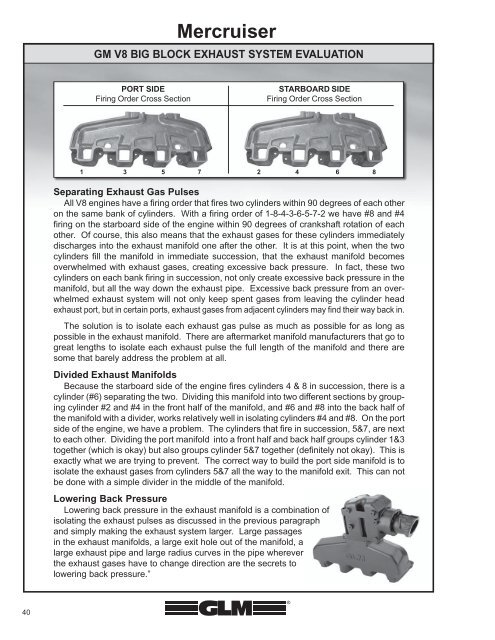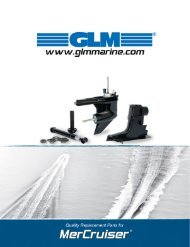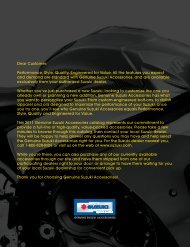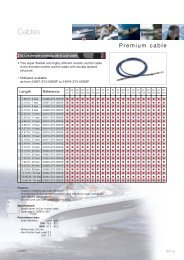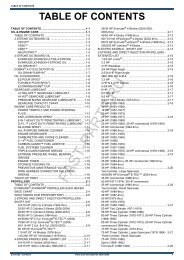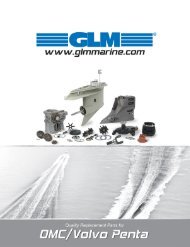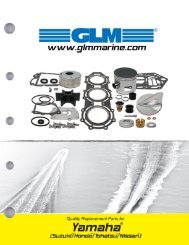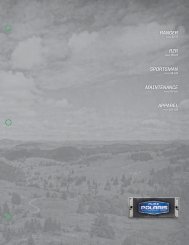Manifold - FAST PARTS
Manifold - FAST PARTS
Manifold - FAST PARTS
You also want an ePaper? Increase the reach of your titles
YUMPU automatically turns print PDFs into web optimized ePapers that Google loves.
Mercruiser<br />
GM V8 BIG BLOCK EXHAUST SYSTEM EVALUATION<br />
PORT SIDE<br />
Firing Order Cross Section<br />
STARBOARD SIDE<br />
Firing Order Cross Section<br />
1 3 5 7 2 4 6 8<br />
Separating Exhaust Gas Pulses<br />
All V8 engines have a firing order that fires two cylinders within 90 degrees of each other<br />
on the same bank of cylinders. With a firing order of 1-8-4-3-6-5-7-2 we have #8 and #4<br />
firing on the starboard side of the engine within 90 degrees of crankshaft rotation of each<br />
other. Of course, this also means that the exhaust gases for these cylinders immediately<br />
discharges into the exhaust manifold one after the other. It is at this point, when the two<br />
cylinders fill the manifold in immediate succession, that the exhaust manifold becomes<br />
overwhelmed with exhaust gases, creating excessive back pressure. In fact, these two<br />
cylinders on each bank firing in succession, not only create excessive back pressure in the<br />
manifold, but all the way down the exhaust pipe. Excessive back pressure from an overwhelmed<br />
exhaust system will not only keep spent gases from leaving the cylinder head<br />
exhaust port, but in certain ports, exhaust gases from adjacent cylinders may find their way back in.<br />
The solution is to isolate each exhaust gas pulse as much as possible for as long as<br />
possible in the exhaust manifold. There are aftermarket manifold manufacturers that go to<br />
great lengths to isolate each exhaust pulse the full length of the manifold and there are<br />
some that barely address the problem at all.<br />
Divided Exhaust <strong>Manifold</strong>s<br />
Because the starboard side of the engine fires cylinders 4 & 8 in succession, there is a<br />
cylinder (#6) separating the two. Dividing this manifold into two different sections by grouping<br />
cylinder #2 and #4 in the front half of the manifold, and #6 and #8 into the back half of<br />
the manifold with a divider, works relatively well in isolating cylinders #4 and #8. On the port<br />
side of the engine, we have a problem. The cylinders that fire in succession, 5&7, are next<br />
to each other. Dividing the port manifold into a front half and back half groups cylinder 1&3<br />
together (which is okay) but also groups cylinder 5&7 together (definitely not okay). This is<br />
exactly what we are trying to prevent. The correct way to build the port side manifold is to<br />
isolate the exhaust gases from cylinders 5&7 all the way to the manifold exit. This can not<br />
be done with a simple divider in the middle of the manifold.<br />
Lowering Back Pressure<br />
Lowering back pressure in the exhaust manifold is a combination of<br />
isolating the exhaust pulses as discussed in the previous paragraph<br />
and simply making the exhaust system larger. Large passages<br />
in the exhaust manifolds, a large exit hole out of the manifold, a<br />
large exhaust pipe and large radius curves in the pipe wherever<br />
the exhaust gases have to change direction are the secrets to<br />
lowering back pressure.”<br />
40


